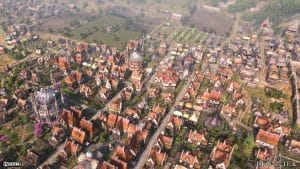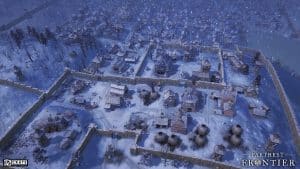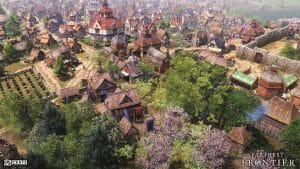Farthest Frontier
Related Games
Description
🔥 What is Farthest Frontier for PC?
Farthest Frontier is a city-building and survival strategy game developed and published by Crate Entertainment, the creators of Grim Dawn. It invites players to guide a group of settlers fleeing a collapsing civilization into a vast and untamed wilderness filled with both danger and opportunity. The experience blends the creativity of city-building with the tension of survival management, creating a slow but deeply rewarding game about endurance, adaptation, and the fragile balance between civilization and nature.
Players begin with only a handful of villagers, a cart of supplies, and the will to survive in the unpredictable frontier. From there, they must harvest resources, construct shelters, grow crops, and defend their settlement from disease, starvation, and raids. Every choice carries lasting consequences, since the game’s detailed simulation governs food decay, soil fertility, and water purity. It is not a forgiving city builder, but one that demands foresight, patience, and an understanding of cause and effect.
Farthest Frontier stands out because of its focus on authenticity and consequence. Progress is earned through careful management and strategic thinking, not through automatic growth or idle mechanics. This makes every milestone whether surviving the first winter or establishing a thriving town feel like a genuine achievement born of perseverance and thoughtful planning.
👉 Features of Farthest Frontier
Deep Survival Simulation
The survival mechanics in Farthest Frontier are both intricate and human in scale. Each villager has unique needs, professions, and emotional states influenced by hunger, safety, and environmental factors. A lack of food or clean water quickly turns into illness or death, while neglecting waste management can cause deadly outbreaks. Watching your town survive each season feels like a victory earned through constant vigilance and care.
The game’s realism extends to the smallest details. Food rots if left unpreserved, diseases spread through poor hygiene, and farmland loses nutrients without rotation. These interlocking systems ensure that success requires not just building structures but understanding the ecosystem that supports them.
Detailed City-Building and Resource Management
Building in Farthest Frontier requires adaptation to terrain, weather, and limited resources. Settlements cannot grow through symmetry alone; each building must fit the landscape and serve the needs of the people. Structures have dependencies, and supply chains form a complex web connecting raw materials to finished goods.
A single piece of bread represents a long chain of production: grain from the field, flour from the mill, firewood from the forest, and the baker’s skilled labor. Each link in this chain is an opportunity to improve efficiency or risk collapse, making management both intellectually satisfying and nerve-wracking.
Dynamic Environment and Seasons
The environment in Farthest Frontier is alive, constantly reacting to weather, time, and player activity. Seasons bring visible change lush summers, stormy autumns, and silent, freezing winters that test even the most prepared settlements. Each shift in weather affects resource availability, morale, and production.
Disasters like fire, drought, and plague arise naturally from poor management or environmental imbalance. A neglected forest can lead to wildfires, and stagnant wells can poison entire districts. Survival depends on awareness and adaptation rather than prediction or luck.
Combat and Defense
While city-building remains the focus, Farthest Frontier also incorporates realistic defensive systems. Raiders arrive in organized groups, targeting storage and production centers, forcing players to plan fortifications and maintain militia forces. Every defense choice walls, towers, or guard posts carries costs in materials and manpower.
Combat is not about spectacle but about consequence. Every lost villager represents a setback in labor and morale, and rebuilding after raids can take entire seasons. Defending the frontier feels exhausting yet meaningful, reinforcing the harsh tone of survival the game embodies.
Customization and Mod Support
Farthest Frontier supports deep customization and community creativity. Players can adjust world size, resource abundance, disease frequency, and raider aggression to fit their preferred experience. Those who want a tranquil, aesthetic builder can disable threats entirely, while others can push themselves to survive under brutal realism.
Mod support further expands possibilities, allowing players to design new structures, tweak balance, or share scenarios. The flexibility of the system turns the game into both a creative sandbox and a demanding survival simulator depending on how you approach it.
Gameplay
Settler Management and Production Chains
At the core of the gameplay lies the human element every villager is a cog in the settlement’s living system. Assigning professions, rotating workers seasonally, and prioritizing essential industries create the rhythm of growth and survival. When a blacksmith falls ill or a hunter dies, production falters, and the consequences ripple through the economy.
Production chains are deeply interconnected. Iron ore becomes bars, which become tools, which in turn boost farming and mining efficiency. These relationships encourage a holistic understanding of development, where each improvement unlocks the potential of others.
Agriculture and Food Preservation
Agriculture in Farthest Frontier demands observation and patience. Crops respond to soil fertility, pests, and temperature fluctuations, so successful farming requires rotation and planning across multiple years. Livestock provide meat, milk, and hides but also consume feed, meaning every benefit comes with a cost.
Food preservation transforms survival into logistics. Root cellars, smokehouses, and granaries extend the lifespan of food, while poor storage can undo an entire season’s work. Understanding how to manage perishables is as vital as winning battles or producing tools.
Exploration and Expansion
The fog of war conceals both opportunity and danger. Scouts can uncover mineral deposits, fertile valleys, and potential raider routes. Expanding too far too fast exposes weak points, but staying small limits growth and resources. Every expansion is a gamble that must be weighed carefully.
Outposts can harvest distant resources, but they require roads, guards, and steady supplies. Each new settlement branch deepens your influence over the world but also stretches your people thin, creating a satisfying tension between ambition and safety.
Trade and Economy
Trade is the bridge between isolation and prosperity. Merchants visit periodically with unique offers, and their timing can determine your survival. Selling surplus goods provides income, but greed can deplete vital reserves before the next winter arrives. Balancing profit and preparation becomes a delicate art.
As your town grows, you can specialize production to dominate certain trades, exporting tools, pottery, or luxury goods in exchange for rare materials. The economic layer evolves naturally, rewarding those who build stable, diversified systems rather than chasing quick profit.
Graphics
Realistic Art Direction and Environmental Detail
Farthest Frontier’s visuals embrace an earthy realism that highlights both beauty and struggle. Forests breathe with individual movement, rivers shimmer under changing light, and cottages feel handcrafted from the land itself. The result is a world that feels tangible and personal, inviting close observation of every small act of life within your town.
The art direction avoids excess gloss, focusing instead on atmosphere and texture. Each structure looks purposeful, and each environment tells a quiet story of survival and human effort. It’s a humble but captivating aesthetic.
Lighting, Weather, and Atmosphere
Dynamic lighting and weather elevate immersion far beyond what most city builders achieve. Fog rolls across fields at dawn, rain patters against thatched roofs, and snowstorms blanket the world in a haunting silence. The transition between seasons is both visual and emotional, marking the passage of time in ways that players feel deeply.
Weather also carries mechanical meaning, influencing farming output, villager health, and even trade routes. The seamless link between beauty and function makes every moment visually stunning yet grounded in gameplay.
Performance and Optimization
Despite the complexity of its systems, Farthest Frontier performs impressively well. The graphical settings scale effectively across hardware, maintaining clarity and readability even in large cities. The clean interface and clear iconography make information accessible without cluttering the screen.
Crate Entertainment continues to refine optimization through regular patches, improving frame rates, reducing bugs, and responding quickly to community reports. It’s a technically sound foundation that supports the game’s growing scope.
Pros and Cons
✔️ Pros
- Deep and realistic survival systems with meaningful interconnections
- Beautiful natural environments and atmospheric seasonal transitions
- Rewarding production chains that encourage strategic planning
- Immersive, handcrafted art direction that enhances emotional tone
- High replay value with customization, mod support, and procedural worlds
❌ Cons
- Steep learning curve that may overwhelm beginners
- Occasional midgame stagnation when production stabilizes
- AI pathfinding and raider behavior can still be inconsistent
- Lack of overarching story or campaign structure for narrative players
ℹ️ Game information
Release Date: 09/08/2022
Update Date: 25/10/2025
Version: v1.0.0
Genre: Strategy / Simulation
Platform: PC
Language: ![]()
![]()
![]()
![]()
![]()
![]()
![]()
![]()
Weight: 4 GB
Additional info: New version includes all DLCs to date
⭐ Installation Instructions
- The game is fully complete, you just need to install it, so there is no need to unpack it or download it from other sources.
- Just run the Farthest Frontier.exe installation file.
- Simply launch the game from shortcut desktop.
⚙️ System Requirements
✅ Minimum:
- OS: Windows 10 64-bit
- Processor: Intel Core i5 3470 @ 3.2 GHz | AMD FX 8120 @ 3.9 GHz
- Memory: 8 GB RAM
- Graphics: NVIDIA GeForce GTX 780 | AMD R9 290, with 3 GB VRAM
- DirectX: Version 11
- Network: Broadband Internet connection
- Storage: 4 GB available space
✅ Recommended:
- OS: Windows 10 64-bit
- Processor: Intel Core i5 4690 @ 3.5 GHz | AMD Ryzen 5 1600x @ 3.6 GHz
- Memory: 16 GB RAM
- Graphics: NVIDIA GeForce GTX 980 | AMD RX 590, with 4GB VRAM
- DirectX: Version 12
- Network: Broadband Internet connection
- Storage: 4 GB available space
Images








